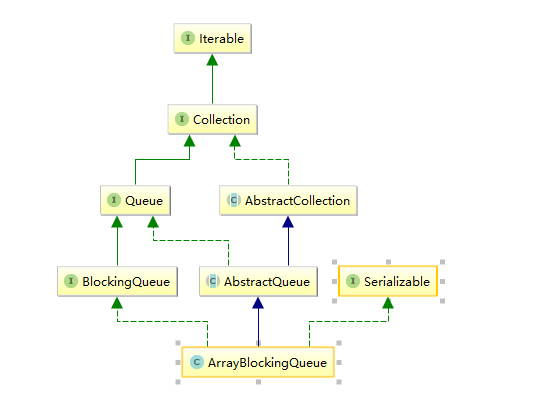java源码阅读之ArrayBlockingQueue
2017-08-17 12:50
495 查看
阻塞队列 (BlockingQueue)是Java util.concurrent包下重要的数据结构,BlockingQueue提供了线程安全的队列访问方式:当阻塞队列
进行插入数据时,如果队列已满,线程将会阻塞等待直到队列非满;从阻塞队列取数据时,如果队列已空,线程将会阻塞等待直到队列非空。
并发包下很多高级同步类的实现都是基于BlockingQueue实现的。
BlockingQueue 的操作方法
BlockingQueue 具有 4 组不同的方法用于插入、移除以及对队列中的元素进行检查。如果请求的操作不能得到立即执行的话,每个方法的表现也不同。这些方法如下:

四组不同的行为方式解释:
抛异常:如果试图的操作无法立即执行,抛一个异常。
特定值:如果试图的操作无法立即执行,返回一个特定的值(常常是 true / false)。
阻塞:如果试图的操作无法立即执行,该方法调用将会发生阻塞,直到能够执行。
超时:如果试图的操作无法立即执行,该方法调用将会发生阻塞,直到能够执行,但等待时间不会超过给定值。返回一个特定值以告知该操作是否成功(典型的是true / false)。
无法向一个 BlockingQueue 中插入 null。如果你试图插入 null,BlockingQueue 将会抛出一个 NullPointerException。
可以访问到 BlockingQueue 中的所有元素,而不仅仅是开始和结束的元素。比如说,你将一个对象放入队列之中以等待处理,但你的应用想要将其取消掉。那么你可以调用诸如 remove(o) 方法来将队列之中的特定对象进行移除。但是这么干效率并不高(译者注:基于队列的数据结构,获取除开始或结束位置的其他对象的效率不会太高),因此你尽量不要用这一类的方法,除非你确实不得不那么做。
ArrayBlockingQueue的继承关系:

ArrayBlockingQueue的源码分析:
废话不多讲,我们直接来分析ArrayBlockingQueue的源码
先看构造函数:
public ArrayBlockingQueue(int capacity);
public ArrayBlockingQueue(int capacity, boolean fair) ;
public ArrayBlockingQueue(int capacity, boolean fair,Collection<? extends E> c);
ArrayBlockingQueue提供了三个构造函数,可以看出容量是必传的参数,这也导致了ArrayBlockingQueue的容量是固定的。fair 表示队列是否是公平的,即入队时先被阻塞的是否先进入队列。
以下是构造的主要过程:
public ArrayBlockingQueue(int capacity, boolean fair) {
if (capacity <= 0)
throw new IllegalArgumentException();
this.items = new Object[capacity]; //初始化数组
lock = new ReentrantLock(fair); //根据传的参数决定是否使用公平锁
notEmpty = lock.newCondition(); //当队列不为空的时候将唤醒此条件
notFull = lock.newCondition(); //当队列容量没有充满的时候唤醒此条件
}
以下是主要的属性
final Object[] items;
int takeIndex;
int putIndex;
int count;
/** Main lock guarding all access */
final ReentrantLock lock;
/** Condition for waiting takes */
private final Condition notEmpty;//为空时需要阻塞
/** Condition for waiting puts */
private final Condition notFull;//容量满时需要阻塞
接下来我们将分析最主要的两个方法:take 和 put
take从队列中拿出一个元素,如果队列为空将会阻塞直到队列不为空并且能够获取到元素
put将一个元素放入队列,如果队列容量已满将会阻塞直到队列容量不满并且能够入队
以下是take的流程:
public E take() throws InterruptedException {
final ReentrantLock lock = this.lock;
lock.lockInterruptibly();//可以看出是通过lock来响应中断的
try {
while (count == 0)
notEmpty.await();//如果队列中没有数据,将会一直阻塞。
return dequeue();
} finally {
lock.unlock();
}
}
/**
* 只发生在持有锁的时候
* Extracts element at current take position, advances, and signals.
* Call only when holding lock.
*/
private E dequeue() {
// assert lock.getHoldCount() == 1;
// assert items[takeIndex] != null;
final Object[] items = this.items;
@SuppressWarnings("unchecked")
E x = (E) items[takeIndex];
items[takeIndex] = null;
if (++takeIndex == items.length)
takeIndex = 0;
count--;
if (itrs != null)
itrs.elementDequeued();
notFull.signal();//通知notFull condition 队列已经有空位了 可以入队了。
return x;
}
put操作类似
public void put(E e) throws InterruptedException {
checkNotNull(e);
final ReentrantLock lock = this.lock;
lock.lockInterruptibly();
try {
while (count == items.length)
notFull.await();
enqueue(e);
} finally {
lock.unlock();
}
}
/**
* Inserts element at current put position, advances, and signals.
* Call only when holding lock.
*/
private void enqueue(E x) {
// assert lock.getHoldCount() == 1;
// assert items[putIndex] == null;
final Object[] items = this.items;
items[putIndex] = x;
if (++putIndex == items.length)
putIndex = 0;
count++;
notEmpty.signal();
}
以上便是ArrayBlockingQueue的两个核心方法,可以看出其实现原理比较简单,是一个典型的生产者消费者模式。但是由于其容量大
小固定,同时put和take使用的是同一个锁(没有办法同时进行put和take),造成了其有很大的局限性。固在线程池中没有默认将其作为阻
塞队列。但是对帮助我们理解阻塞队列有很大帮助。
进行插入数据时,如果队列已满,线程将会阻塞等待直到队列非满;从阻塞队列取数据时,如果队列已空,线程将会阻塞等待直到队列非空。
并发包下很多高级同步类的实现都是基于BlockingQueue实现的。
BlockingQueue 的操作方法
BlockingQueue 具有 4 组不同的方法用于插入、移除以及对队列中的元素进行检查。如果请求的操作不能得到立即执行的话,每个方法的表现也不同。这些方法如下:

四组不同的行为方式解释:
抛异常:如果试图的操作无法立即执行,抛一个异常。
特定值:如果试图的操作无法立即执行,返回一个特定的值(常常是 true / false)。
阻塞:如果试图的操作无法立即执行,该方法调用将会发生阻塞,直到能够执行。
超时:如果试图的操作无法立即执行,该方法调用将会发生阻塞,直到能够执行,但等待时间不会超过给定值。返回一个特定值以告知该操作是否成功(典型的是true / false)。
无法向一个 BlockingQueue 中插入 null。如果你试图插入 null,BlockingQueue 将会抛出一个 NullPointerException。
可以访问到 BlockingQueue 中的所有元素,而不仅仅是开始和结束的元素。比如说,你将一个对象放入队列之中以等待处理,但你的应用想要将其取消掉。那么你可以调用诸如 remove(o) 方法来将队列之中的特定对象进行移除。但是这么干效率并不高(译者注:基于队列的数据结构,获取除开始或结束位置的其他对象的效率不会太高),因此你尽量不要用这一类的方法,除非你确实不得不那么做。
ArrayBlockingQueue的继承关系:

ArrayBlockingQueue的源码分析:
废话不多讲,我们直接来分析ArrayBlockingQueue的源码
先看构造函数:
public ArrayBlockingQueue(int capacity);
public ArrayBlockingQueue(int capacity, boolean fair) ;
public ArrayBlockingQueue(int capacity, boolean fair,Collection<? extends E> c);
ArrayBlockingQueue提供了三个构造函数,可以看出容量是必传的参数,这也导致了ArrayBlockingQueue的容量是固定的。fair 表示队列是否是公平的,即入队时先被阻塞的是否先进入队列。
以下是构造的主要过程:
public ArrayBlockingQueue(int capacity, boolean fair) {
if (capacity <= 0)
throw new IllegalArgumentException();
this.items = new Object[capacity]; //初始化数组
lock = new ReentrantLock(fair); //根据传的参数决定是否使用公平锁
notEmpty = lock.newCondition(); //当队列不为空的时候将唤醒此条件
notFull = lock.newCondition(); //当队列容量没有充满的时候唤醒此条件
}
以下是主要的属性
final Object[] items;
int takeIndex;
int putIndex;
int count;
/** Main lock guarding all access */
final ReentrantLock lock;
/** Condition for waiting takes */
private final Condition notEmpty;//为空时需要阻塞
/** Condition for waiting puts */
private final Condition notFull;//容量满时需要阻塞
接下来我们将分析最主要的两个方法:take 和 put
take从队列中拿出一个元素,如果队列为空将会阻塞直到队列不为空并且能够获取到元素
put将一个元素放入队列,如果队列容量已满将会阻塞直到队列容量不满并且能够入队
以下是take的流程:
public E take() throws InterruptedException {
final ReentrantLock lock = this.lock;
lock.lockInterruptibly();//可以看出是通过lock来响应中断的
try {
while (count == 0)
notEmpty.await();//如果队列中没有数据,将会一直阻塞。
return dequeue();
} finally {
lock.unlock();
}
}
/**
* 只发生在持有锁的时候
* Extracts element at current take position, advances, and signals.
* Call only when holding lock.
*/
private E dequeue() {
// assert lock.getHoldCount() == 1;
// assert items[takeIndex] != null;
final Object[] items = this.items;
@SuppressWarnings("unchecked")
E x = (E) items[takeIndex];
items[takeIndex] = null;
if (++takeIndex == items.length)
takeIndex = 0;
count--;
if (itrs != null)
itrs.elementDequeued();
notFull.signal();//通知notFull condition 队列已经有空位了 可以入队了。
return x;
}
put操作类似
public void put(E e) throws InterruptedException {
checkNotNull(e);
final ReentrantLock lock = this.lock;
lock.lockInterruptibly();
try {
while (count == items.length)
notFull.await();
enqueue(e);
} finally {
lock.unlock();
}
}
/**
* Inserts element at current put position, advances, and signals.
* Call only when holding lock.
*/
private void enqueue(E x) {
// assert lock.getHoldCount() == 1;
// assert items[putIndex] == null;
final Object[] items = this.items;
items[putIndex] = x;
if (++putIndex == items.length)
putIndex = 0;
count++;
notEmpty.signal();
}
以上便是ArrayBlockingQueue的两个核心方法,可以看出其实现原理比较简单,是一个典型的生产者消费者模式。但是由于其容量大
小固定,同时put和take使用的是同一个锁(没有办法同时进行put和take),造成了其有很大的局限性。固在线程池中没有默认将其作为阻
塞队列。但是对帮助我们理解阻塞队列有很大帮助。
相关文章推荐
- java1.7集合源码阅读:ArrayBlockingQueue
- 《java.util.concurrent 包源码阅读》06 ArrayBlockingQueue
- Java多线程 -- JUC包源码分析5 -- Condition/ArrayBlockingQueue/LinkedBlockingQueue/Deque/PriorityBlockingQueu
- ArrayBlockingQueue 源码阅读与分析
- 阅读ArrayBlockingQueue源码了解如何利用锁实现BlockingQueue
- J.U.C并发框架源码阅读(八)ArrayBlockingQueue
- 源码解析关于java阻塞容器:ArrayBlockingQueue,LinkedBlockingQueue等
- ArrayBlockingQueue 源码阅读 问题(一)
- Java 容器源码分析之ArrayBlockingQueue和LinkedBlockingQueue
- java多线程系列(九)---ArrayBlockingQueue源码分析
- 《java.util.concurrent 包源码阅读》19 PriorityBlockingQueue
- jdk 源码分析(11)java ArrayBlockingQueue 缓存队列分析
- ArrayBlockingQueue源码阅读
- Java 并发 --- 阻塞队列之ArrayBlockingQueue源码分析
- Java ArrayBlockingQueue 源码
- JDK 1.8 ArrayBlockingQueue 源码阅读(一)插入
- Java集合源码学习(16)_BlockingQueue接口的实现ArrayBlockingQueue
- 关于java ArrayBlockingQueue 源码解析的小疑惑
- Java多线程 -- JUC包源码分析5 -- Condition/ArrayBlockingQueue/LinkedBlockingQueue/Deque/PriorityBlockingQueue
- Java concurrent Framework并发容器之ArrayBlockingQueue(1.6)源码分析
